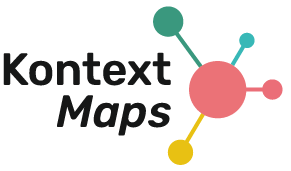Planning your map‘s structure? It might seem easy, but it‘s best to follow some main guidelines. We‘ve put together a clear guide for you. You might wonder why knowing what structure you‘ll use should be so important to you anyways. Well… it helps to convey your information in a clear and concise way. Bluntly said: the person on the other end will have a clue what you‘re talking about, without being confused 😉
Choose your topic
Planning and building structures is easy to do in a KontextMap. But first, you need to know what it is you want to structure. It‘s the most important single question you have to ask yourself! What‘s your topic? Choose one subject. This can be broad, but you might consider if there‘s a more concrete question that you would like to answer. We recommend to narrow it down as much as possible. An example: we could develop a KontextMap about how meteorology in general. It would be huge. So to get answers and actionable insights you could go further if you focus on the question: „How can we predict the weather?“.
Identify the aspects
Let‘s continue with the weather forecasting example. To start our map, we need to identify all the relevant aspects to the answer of our question. On a practical level, you might think of the physical tools used to predict the weather. But how did they come to be? And why do we want to know what the weather is going to be like anyways? how can we be sure that the forecast is accurate? And how do we properly communicate the weather through media?
There‘s all kinds of perspectives you can take. It helps to step out of your comfort zone: go economical, the political left or right, consider technology, look at a personal scale or take a step back and look at the larger perspective; look at data and look at historical points of view. You‘ll see that you’ve quickly collected many perspectives to approach your topic!
Lateral thinking
Not everyone‘s got a brain that‘s easily that creative. A method we love for brainstorming KontextMaps, is physician and psychologist Edward De Bono‘s idea of lateral thinking: problem solving in a creative and indirect way. Take your idea and flip it over, completely. When he first discussed this technique in 1967, he promoted the Judgment of Solomon as the example. This story from the bible might ring a bell: king Solomon suggested cutting a baby in half when two women claimed to be its mom, only for the real mom to beg to give the baby away instead of killing it.
Basically, lateral thinking revolves around taking initially absurd viewpoints, to come to great results. Still to abstract for you? A famous way to apply it is via the six thinking hats of De Bono. Although this method is often used in group brainstorming, a single person can also „wear the hats“ to establish different viewpoints.
Connecting and de-connecting
Now, we‘ll put our main topic on the map and surround them by the sub-topics. What can we connect? Draw lines and develop your different aspects. But also sometimes take a step back? Does a certain connection really make sense? Or is there something else that needs to go in between?
„Chunking„ your info in these bite-sized pieces has many benefits. When information is broken down, we can absorb more units in our working memory, but also into our long-term memory If the chunks are well thought through, they are easier to learn and recall. Want an example of how we broke down a big, seemingly daunting topic into smaller, consumable chunks that are interconnected? We‘ve detailed how we developed our 5G KontextMap here.
Dive in
Now, it‘s time to really dive in. We‘ve created a KontextMap with a main idea and several chunked down aspects, but there‘s more (fun!) work to do. Each perspective has it‘s own necessary info, and those info‘s might have even more. How were those weather tools created? How do they work? And what is it that they exactly measure? That‘s just one of the ways you could elaborate on the ‚tool‘ aspect of your weather forecasting map.
Taking it to the next level, we add layers and in this way create a hierarchy in the KontextMap. This will result in a KontextMap that is structured in three different dimensions: topic wise; aspect from different perspectives; and layered hierarchy. You‘ve created both clarity and depth.
Picture by Nina Luong on unsplash

